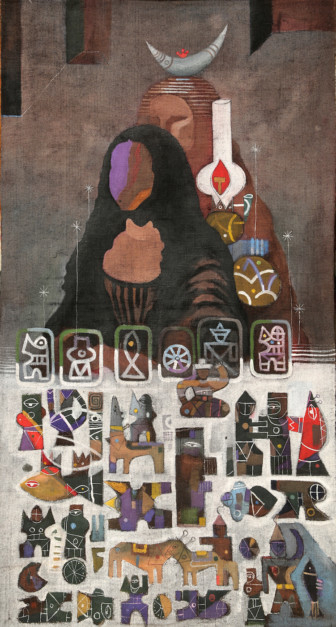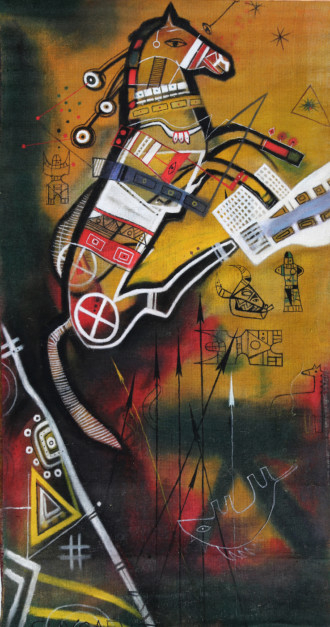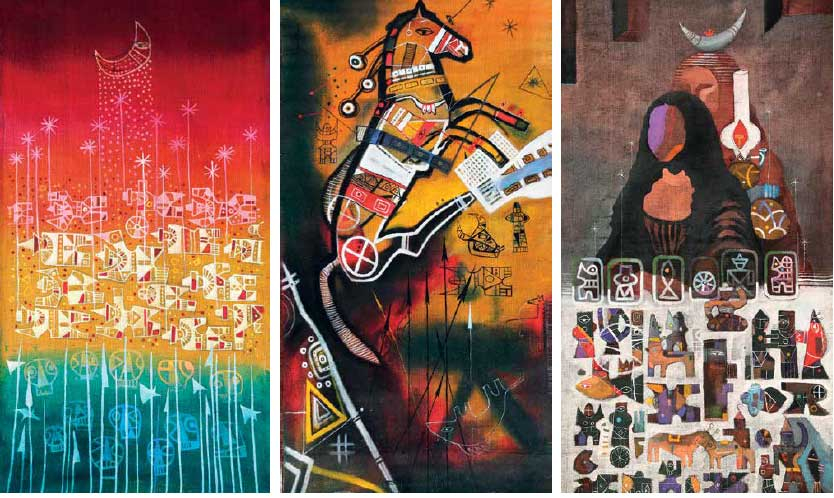Kyrgyz artist Yuristanbek Shygaev’s first solo exhibition in Dubai, Archaic’s Echo features paintings that are inspired by the cultural heritage and traditions of Kyrgystan. Presented as scrolls painted on burlap, the colourful paintings depict well-known Kyrgyz myths and legends in a contemporary style. They are filled with figures and symbols that speak about the history, philosophy, landscape and nomadic traditions that have shaped the identity and way of life of the Kyrgyz people. By echoing these archaic myths, traditions and imagery in his own way, the artist comments on what is happening in our world today and the fragility of our relationships with our roots and core values, with other human beings and with nature.
Shygaev is an iconic figure of Kyrgystan’s contemporary art scene. Besides being an award-winning artist who has shown his work across the world and an art professor, he has also served as the director of the State Museum of Fine Arts in Bishkek. He graduated from the St Petersburg Academy of Fine Arts and began his artistic career in the 1980s when his country was emerging from the Soviet Union to become an independent nation. His practice was deeply influenced by this transition and historical transformation.
“After independence we got the creative freedom to express our identity and ideas. A wave of nationalism swept across the country and I wanted to find a new way to reflect these changes. I decided to look back in our history and seek inspiration from my cultural heritage and traditions. I did extensive research on Kyrgyz myths and legends, studied the symbols in ancient rock carvings, and tried to understand the old nomadic way of life. While exploring the collective subconscious of my ancestors, which has been passed down through generations as mythology and poetic symbols, I discovered an astonishing modernity in the techniques of the nomadic archaic. So, I began a dialogue with the ancient culture based on my own experience of modernism and developed a visual language that presents traditional folklore in a contemporary style and connects the past with the present, offering renewed inspiration for the future,” Shygaev says.
His use of burlap scrolls obtained from a local sack factory instead of canvases relates to the nomadic history of his people. “The yurts or tents in which the Kyrgyz tribes lived could be folded and carried with them wherever they went. My scrolls are similarly portable. It is easy to fold, transport and install them when I travel across the globe for my exhibitions, and they truly embody the culture I have tried to depict in my compositions,” he says.
Many of the paintings in the show tell stories from a famous Krygyz epic poem about the legendary hero Manas. A painting titled Sunny Horse depicts a popular tale about how the brave warrior’s horse saved his life by jumping over a trap laid out by his enemies, while also highlighting the significance of the horse in the daily life of the mountain dwelling nomads. Another one depicts the eagle that flew high and warned Manas about enemies lurking in the mountains. The traditional storytellers who travel from place to place narrating these stories and passing them down from one generation to the next appear often in Shygaev’s paintings.
Other recurring motifs include triangles representing the mountains that are a constant presence in the lives of the Kyrgyz people, a wheel signifying their nomadic existence, the sun and moon reflecting the cycles of the universe, and fish and sheep symbolising the importance of the rivers, lakes and lush greenery that sustain life in the mountains. These symbols, inspired by ancient rock carvings speak about the deep connection of the people with their environment and seek to encourage the next generation to maintain this relationship.
The artist has also depicted scenes from daily life and the rituals and traditions of various Kyrgyz tribes, conveying the philosophical and spiritual aspects of their culture. For example, Kumbez (The Tomb) refers to the ritual of remembering those who have passed away and being aware of the eternal cycle of life and death. Another composition shows a tribe on the move with their folded yurts, carpets and utensils loaded on bullock carts with the bells strung across the horns of the bullocks tracking the movement.
In some of his compositions Shygaev has combined influences from traditional Kyrgyz art and Western modernism. The Kiss is clearly inspired by Klimt’s famous painting of the same name, but the central figures here are two women in traditional tribal Kyrgyz attire praying for the safety of the men going to war. In the Bride from the Louvre, the artist humorously alludes to the ancient Kyrgyz custom of a man kidnapping the woman he loves to marry her and imagines that one of his royal ancestors might have brought the Mona Lisa home to be his bride.
Archaic’s Echo will run at Andakulova Gallery, Damac Park Towers, DIFC, until June 15.














